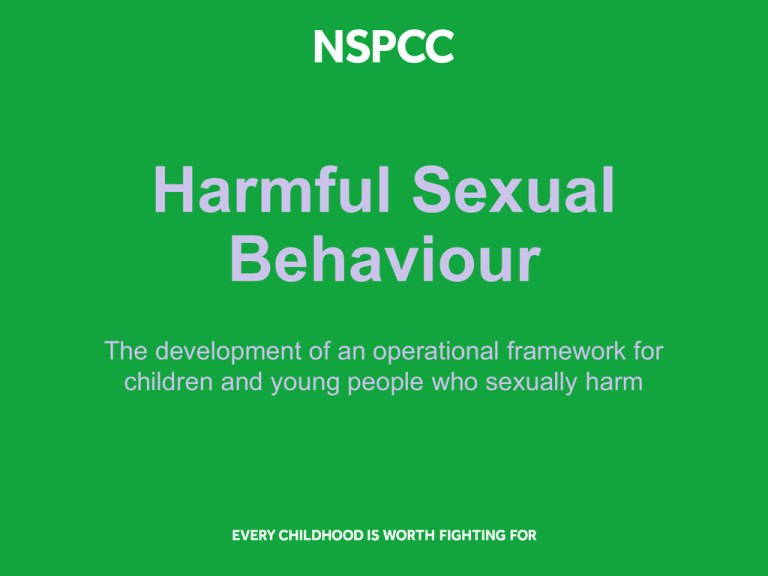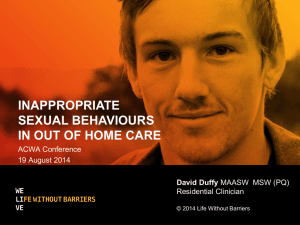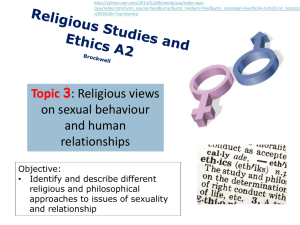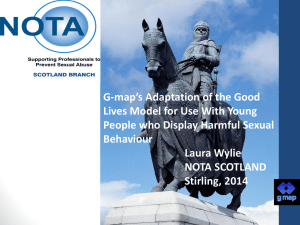WI5 Development of a national operational framework for
advertisement

Harmful Sexual Behaviour The development of an operational framework for children and young people who sexually harm Sherry Malik Director of Children’s Services Development & Delivery, NSPCC 2 Innovation session • Brief research review – the problem of children and young people with harmful sexual behaviours • Co-ordinated partnership response – the development of an operational framework for children and young people who sexually harm • How it feels to work with these issues and a local response from Surrey County Council • Where are we now, next steps and how to get involved 3 The scale and evidence of the problem Dez Holmes, Director, Research in Practice 4 Children and young people with harmful sexual behaviours Scale of the problem • children and young people account for approximately a quarter of all convictions against victims of all ages (Vizard, 2004) • ...and a third of all sexual abuse coming to the attention of the professional system in the UK (Erooga and Masson, 2006) • …65.9% of the contact sexual abuse reported by children and young people was perpetrated by other children and young people under the age of 18 (Radford et al, 2011) 6 Evidence of system failure "It would be hard to describe the current state of responses and services to families of young people who commit sexual assaults in terms other than disorganised, sporadic and unpredictable” "Treatment with children and YP was fundamentally founded on a set of unproven assumptions drawn from theories about adult pedophilia... which had shaded into rigid dogma... had to led to juvenile treatment practices that were a mismatch for children and teens" A contested area of policy and practice • Hidden nature of abuse makes recognition difficult • Stigma and shame may lead to under-reporting • Dual identities of perpetrator/victim conceptually challenging • Power of language • Currently no national strategy or overarching service delivery framework A highly diverse group • Vast majority of adolescents with sexually abusive behaviours are male • Girls with abusive sexual behaviours come from particularly chaotic and dysfunctional family backgrounds, with higher levels of sexual victimisation and other abuse • Young learning disabled people = particularly vulnerable group Young people with HSB • Highly problematic family backgrounds and multiple disadvantages and adversities • High rates of victimisation and trauma; social skills deficits; lack of sexual knowledge; social anxiety • Most target victims known to them, in many cases family members (intra-familial abuse) • Sexual behaviours online: YP with these behaviours may not share the backgrounds and risk profiles of those who commit contact sexual offences Parents • Facing a child’s HSB can be a profoundly difficult experience and parenting competence and resources can be undermined. Many parents are lonely and isolated and face social stigma and hostility in response to their child’s behaviour • Attention should be given to identifying and building upon family strengths Assessment and interventions resiliencefocused evidencebased tiered holistic proportion ate multimodal strengthsbased Coordinated responses • Lack of early intervention • Few examples of holistic, multi-agency assessments or interventions • Case management often compromised by poor communication and information sharing So • No longer working together on HSB? • Role of LSCBs and MAPPAs? • Needs analysis Developing an operational framework for HSB Pat Branigan, NSPCC 17 The operational framework will: develop responses ranging from early community based assessment and intervention with low risk cases to intensive work with the highest risk promote effective assessment as the key to ensuring that cases enter the right part of the system promote the advantage of involving frontline agencies and workers in earlier recognition activity (training for education staff, residential workers, and foster carers) assessment, and intervention encourage interagency work designed to reduce the isolation and anxieties that are commonly felt in decision making for this group promote the use of a shared workforce language, skills and training exchange and development of appropriate local peer support systems 18 The process so far Co-production and proportionate response Based on learning from the last 20 years and in the context of the current government ‘terms of trade’ A framework developed alongside an implementation plan Input, support and challenge from the frontline in development A ‘product’ by the end of 2014 19 Development group NSPCC initiated and co-ordinated. Includes: 15 local areas involved through the practice working group Office for the Children’s commissioner, LGA, linking with NICE Observers from central government departments – Home Office, DH, CAMHS Academics, independent experts, authors and research partners on HSB Large national charities NSPCC, Action for Children, Lucy Faithfull, Barnados, Brook, Ms Understood Partnership YJB, Police, CEOP, NOMS/MAPPA, AIM Associates, CAPE, Glebe House 20 Where are we now Communication plan Implementation planning group Framework development overview group Framework development group Piloting and feedback Practice working group 21 Amanda Carpenter-Jago Team manager ACT Surrey County Council 22 Current issues Responding to Harmful Sexualised Behaviours – feedback from our practice working group Lack of appropriate training and support for staff across the lead agencies regarding harmful sexualised behaviours in children and young people Inconsistent responses to allegations regarding harmful sexualised behaviours in children and young people Poor clarity around communication and sharing of information following an allegation or incident of harmful sexualised behaviour Service delivery – need for joined up thinking across all of the lead agencies not only for assessment but also intervention and support 23 How it feels to work in this environment Feedback from our practice working group “No clarity [regarding] agency roles and responsibilities” “Harmful sexual behaviour in children and young people must be viewed as an ongoing need, not a current trend or hot topic” “Complete lack of support consistent quality supervision, debriefing, consultation and appropriate counselling facilities for all professionals who work with children and young people with harmful sexual behaviours” “At times professionals are frightened of discussing allegations with children and young people” Surrey County Council’s Response ACT (Assessment, Consultation and Therapy) is part of Countywide Services, Children’s Services, Surrey County Council, established in 1995. Community based therapeutic service that provides consultation, assessments, post assessment therapeutic treatment plans and training to reduce the risk of children and young people continuing to harm sexually into adulthood, and protection strategies to safeguard the wider community. Works with the families and carers of children and young people to help their understanding of what has happened, to enable them to support their child or young person whilst they attend ACT. During the period April 2013 and March 2014 ACT received over three hundred enquiries. ACT – aims to…. ACT • work with the community to reduce harmful sexual behaviour by children and young people • assess children and young people whose sexual behaviour is harmful or problematic • provide children and young people with a therapy service to assist in the prevention of their harmful sexual behaviour • co-ordinate intervention in Surrey with children and young people who have been harmful sexually • to offer advice, consultation and training to other practitioners, teams and professional agencies • to contribute to research and evaluation Next steps 27 If nothing is done…….. Children and young people account for approximately a quarter of all convictions against victims of all ages and a third of all sexual abuse coming to the attention of the professional system in the UK. “We owe it to these children and young people to assist them to understand their harmful sexual behaviour and support them to hopefully move away from such behaviour and have a positive future. We also owe it to the potential victims of these children and young people they may create if their harmful sexual behaviour is not addressed as soon as possible” Professional who works with children and young people with sexually harmful behaviours Importance of this work needs to be finally recognised nationally. An operational framework is the first step towards a strategic, statutorily fully supported and consistent approach across all of the lead agencies responsible for safeguarding and care of children and young people. Questions • Based on what you have heard how might this help working in your local area on HSB issues? • What would be the barriers to adopting and embedding such an operational framework in your local area? • Are you interested in being kept informed and even being a pilot area for this framework in 2015? 29 Thank You Photography by Tom Hull. The children pictured are volunteers and models. 30










